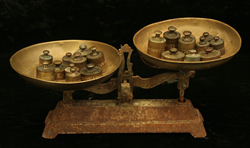
If you’re using a phantom-powered condenser mic, the connections are different.
First, turn off any phantom power in your recorder-mixer.
Connect your mic to a standalone phantom-power supply, and connect the supply output to the impedance-matching adapter.
If your mixer has XLR inputs, they are low-Z balanced.
In this case, simply connect the mic to the mixer using a mic cable with a female XLR on the mic end and a male XLR on the mixer end.
A low-Z mic input is typically about 1500 ohms, so it provides a bridging load to a mic that is 150 to 300 ohms.
Should I Consider Impedance When Connecting Two Line-Level Devices?
This is seldom a problem. In most audio devices, the impedance of the line output is low—about 100 to 1000 ohms. The impedance of the line input is high—about 10 kilohms to 1 megohm. So every connection is bridging, and there is maximum voltage transfer.
Some audio devices, such as passive equalizers, require a terminating resistor at the input or output for best performance.
Can I Connect One Source To Two Or More Loads?
Usually yes. Several devices can be connected in parallel across one line output.
Suppose you connect a mixer output simultaneously to a recorder input, an amplifier input, and another mixer’s input in parallel. The combined input impedance of those three loads might be 4000 ohms, which still presents a bridging load to the mixer’s 100-ohm output impedance.
Microphones are a different story. Suppose you’re recording a concert. If you connect one mic to the PA mixer and also to your recording mixer with a Y cable, the combined input impedance will be about 700 ohms or less. This can load down some microphones, reducing the bass in dynamic mics or causing distortion in condenser mics.
To prevent the loading, put a 270 ohm 1 percent resistor in series with Pin 2 and Pin 3 in each leg of the Y cable.
Can I Connect Two Or More Sources To One Input?
Not recommended. The low output impedance of one source will load down the output of the other source, and vice versa. This can cause level loss and distortion. The same goes for two mics into one mic input. It’s better to use a small external mixer.
As another option, put a series resistor in line with each device before combining them. That prevents each device from loading down the other. A minimum resistor value might be 470 ohms per source. If the source is balanced, use one resistor on pin 2 and one on pin 3—two 1percent resistors per source.
Summary
— Impedance (Z) is the opposition to alternating current, measured in ohms.
—Microphones and line outputs are usually low Z.
—Electric guitars, acoustic-guitar pickups, instrument inputs and line inputs are usually high Z.
—XLR mic inputs are low impedance; phone jack mic inputs are high impedance.
—Loudpeakers are usually 4 to 8ohms.
—Equal impedances in parallel result in half the impedance.
—Equal impedances in series result in twice the impedance.
—Connect low-Z sources to low-Z inputs. (A low-Z input is usually 7 to 10 times the source impedance, but it’s still called a low-Z input.)
—Connect high-Z sources to high-Z inputs.
—Connect a low-Z source to a high-Z input through a step-up transformer (impedance matching adapter).
—Connect a high-Z source to a low-Z input through a step-down transformer (impedance matching adapter, or direct box).
Bruce Bartlett is a microphone engineer (www.bartlettmics.com), recording engineer, live sound engineer, and audio journalist.
